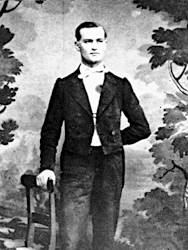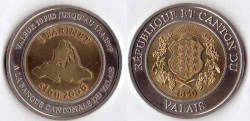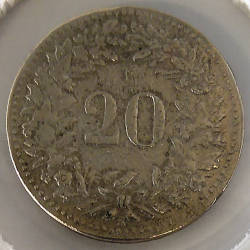Grotte à Farinet
Useful Information
| Location: |
74660 Vallorcine.
From Chamonix follow valley upstream, D1506, to Le Buet. (46.020363, 6.910180) |
| Open: |
Cave:
MAY to NOV daily. Restaurant: 15-MAY to 15-OCT daily. [2022] |
| Fee: |
free. [2022] |
| Classification: |
 Talus Cave Talus Cave
|
| Light: |
 LED Lighting
bring torch LED Lighting
bring torch
|
| Dimension: | |
| Guided tours: | self guided, D=90 min. |
| Photography: | allowed |
| Accessibility: | no |
| Bibliography: |
André Donnet (1980):
La véritable histoire de Joseph-Samuel Farinet, faux-monnayeur
Lausanne, Payot, 1980.

André Donnet (1980): Farinet devant la justice valaisanne (1869-1880) Dossiers de procédure pénale publiés par André Donnet, 1980, Bibliotheca Vallesiana 16, Imprimerie Pillet, Martigny, Diffusion: Pavot, Lausanne.  pdf
pdf
Charles Ferdinand Ramuz (1932): Farinet, ou la fausse monnaie, . |
| Address: |
Cascade de Berard, VC N°1 Dite de Bérard, 74660 Vallorcine, Tel: +33-623-80-64-65.
Maison de la Mobilité et du Tourisme, 2 place de la Gare, 74100 Annemasse, Tel: +33-450-95-07-10. |
| As far as we know this information was accurate when it was published (see years in brackets), but may have changed since then. Please check rates and details directly with the companies in question if you need more recent info. |
|
History
| 1873 | pursued by the Swiss gendarmes Joseph Farinet uses the cave as hideout. |
| 17-APR-1880 | Joseph Farinet dies in the gorges of Saillon in Switzerland under mysterious circumstances. |
| 1992 | Vallon de Bérard nature reserve created. |
| 2021 | cave reopened after refurbishment. |
Description



The Grotte à Farinet (Farinet’s Cave) was named after Joseph-Samuel Farinet (*1845-✝1880). He was an infamous counterfeiter and smuggler with a big heart, giving his faked coins to the poor. When he was pursued by the Swiss gendarmes in 1873, he used the cave successfully as hideout. The cave is located on the northern side of the vallée de Chamonix, opposite the massif du Mont-Blanc, and the trail offers great views on the more than 4,000 m high mountain ridge.
Joseph Farinet is today considered a "Swiss Robin Hood". He was a blacksmith, but at some point he chose to make counterfeit money and distribute it to the poorest. His end at the age of 35 is mysterious, in 1880 his body was found in the gorges of Saillon in Switzerland. He may have had an accident, or he was killed by a pursuer. There was the rumour he was killed by a police bullet, but the official document about his death states that he had died of a fractured skull. And all the time he was officially a criminal, convicted several times in absentia. At that time he was not buried in the sacred enclosure, where he was buried is unknown.
In 1939 a movie about him was made, and for this purpose a fake tomb was created at the foot of the bell tower of the Sainte-Catherine church in Saillon, Switzerland. The movie Farinet ou l’Or dans la montagne (Farinet and the Gold of the Mountains) by Swiss director Max Haufler. The movie followed the book Farinet, ou la fausse monnaie by Charles Ferdinand Ramuz, a novel which describes him not as a counterfeiter, but as a "vrai-monnayeur", a precursor to free banking. There was even a new legend born, that the fake grave was a real grave, he was actually relocated and the famous Abbé Pierre himself held the service. This legend is still published on official websites, its even on the German Wikipedia page. Farinet actually was a counterfeiter and exclusively forged Swiss 20 Rappen coins made of the alloy billon. This alloy is extremely hard, it was quite easy to make an imprint in white steel to produce fake coins. The 20 Rappen coins were called «Farinets» by the locals, more than a third was actually faked.
Beneath the cave there is also a small exhibition about Farinet in the Musée de la Fausse Monnaie (Museum of False Money) in Saillon. And the canton of Valais launched a medal called «Farinet» in 1998, which could be exchanged for ten Swiss Franks at the cantonal bank until a certain date. In May 2017, the tourism office of the Valais printed a total of 500,000 «Farinet». Legally they are not money, they are more like coupons, but they have the value of a Franc and are accepted by over a hundred shops between Monthey and Salgesch. An exchange office in Sion sells notes with a value of 1, 2, 5, 10, 13, 20, 50 and 100 farinets.
The cave is well developed, there are trails, a stone staircase with railing, numerous explanatory signs, and even electric light. Located only 10 minutes walk from the restaurant Cascade de Berard at the homonymous waterfall. The good development of the cave is the result of its closure. The cave was always accessible by a walking trail, originally without much development except for a simple trail. A few years ago the old cave entrance was closed due to the instability of the rock above. For this reason a new pathway was built and the interior of the cave completely redesigned. The new staircase allows to enter the cave from the other side. The electric light is on demand, the cave is open without restrictions, but during winter, it’s less a matter of being open but a matter of bad weather conditions or snow and ice making a cave trip impossible.
The rocks here are crystalline rocks of the basement, which are exposed here at the center of the Alpine ridge. Here the uplift was highest and the overlying limestones and dolomites were eroded. The crystalline rocks are mostly metamorphic rocks which are insoluble. As a result there is no karstification, only erosional and tectonic caves can be found. And there are very few and small caves only. So this is one of the rare tectonic caves, created by the collapse of the mountain side. Huge boulders came to rest, with several huge cracks between them, this cave is the biggest. There is a small river which enters the crack on one side and forms an underground waterfall, but this cave river is not responsible for the cave formation, it just chose the cave after it formed. Most likely the cave is quite young, it might have formed since the end of the last cold age, because glaciers flowing down the valley would have destroyed the cave. So it is less than 10,000 years old.
The village tries to make the waterfall a tourist destination by adding additional sights. A via ferrata which will cross the waterfall, an educational trail about fauna, flora, and geology, and the renovation of the Bérard refuge are on the way. The restaurant is located on a spectacular location, but the rocks are unstable and so they plan to relocate the restaurant soon. The work was financed by the Communauté de Communes (Community of Communes) with the support of the Auvergne-Rhône-Alpes Region. Unfortunately the cave, although open only for a year, has already been vandalized, and as a result the accessibility will probably be changed soon.
The easiest way to reach the waterfall is a 1 km walk on a single lane gravel road from the highway, about 600 m south of Le Buet. It’s the access road for the Restaurant Cascade de Bérard. But the generally advertised route is from the hamlet of Le Buet, there is a huge parking lot at the highway opposite the Hôtel du Buet (1,337 m asl). The trail to the cascade is about 30 minutes uphill, through the hamlet La Poya, to the Cascade de Bérard (1,430m asl). The cave is located a little uphill from the waterfall, about 10 minutes walk, and both are very well signed and there is a well maintained path from the valley to the waterfall and the cave. There is also a bridge across the river, which offers a great view of the waterfall and railings at the steep passages, so it is intended for families and non-mountaineers. Nevertheless, it’s a short but rather steep walk, and you should take your time, especially if you are not very fit.
 Search DuckDuckGo for "Grotte à Farinet"
Search DuckDuckGo for "Grotte à Farinet" Google Earth Placemark
Google Earth Placemark Joseph-Samuel Farinet
Joseph-Samuel Farinet  Grotte à Farinet
Grotte à Farinet  Index
Index Topics
Topics Hierarchical
Hierarchical Countries
Countries Maps
Maps